Your smartphone's camera is a powerhouse for concert photography. You can capture rapid-fire shots with burst mode, balance tricky lighting using HDR, and create artistic motion blur with slow shutter speeds. Manual focus lets you nail sharpness in dim venues, while night mode brings out details in low light. Wide-angle lenses help you frame the entire stage, and accessories like mini tripods keep your shots steady. Don't forget to use editing apps to polish your photos on the spot. By mastering these techniques and exploring your phone's pro features, you'll take your concert photography to the next level.
Master the Burst Mode
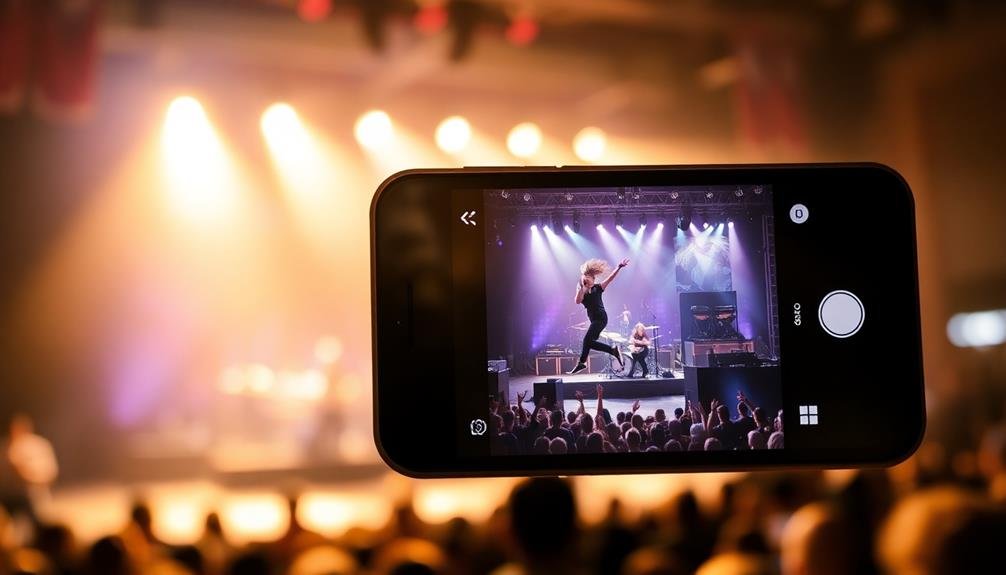
The burst mode is your secret weapon for capturing electrifying concert moments. It allows you to take multiple shots in rapid succession, increasing your chances of getting that perfect frame. To use burst mode, simply press and hold your phone's shutter button. Your device will snap a series of photos until you release it.
When using burst mode at concerts, timing is vital. Anticipate key moments like guitar solos, jumps, or crowd interactions. Start the burst just before the action peaks to guarantee you don't miss anything. Remember, lighting conditions change rapidly at concerts, so burst mode helps compensate for sudden flashes or dimming.
After taking a burst, review your shots immediately. Select the best ones and delete the rest to save storage space. Look for sharp focus, interesting compositions, and authentic emotions. Don't be afraid to experiment with different angles and distances while using burst mode.
For the best results, combine burst mode with other techniques. Use it while panning to capture movement, or when shooting in low light to increase your odds of a clear shot. With practice, you'll master this powerful tool and elevate your concert photography game.
Utilize HDR for Lighting Challenges
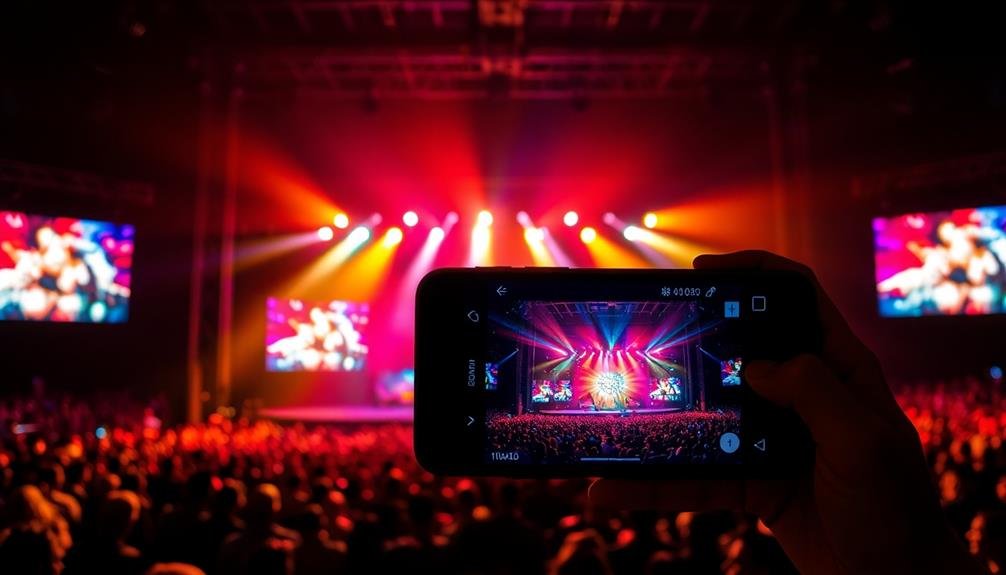
Concerts present unique lighting challenges that can confound even experienced photographers. That's where HDR (High Dynamic Range) mode on your phone can be a game-changer. When you're faced with stark contrasts between bright stage lights and dark audience areas, HDR can help you capture a more balanced image.
Here's how to make the most of HDR at concerts:
- Enable HDR mode in your camera settings before the show starts.
- Keep your phone steady when shooting, as HDR takes multiple exposures.
- Use HDR for wide shots that include both the stage and audience.
- Experiment with HDR for capturing backlit performers.
- Be mindful of moving subjects, as HDR works best with still scenes.
Experiment With Slow Shutter Speeds
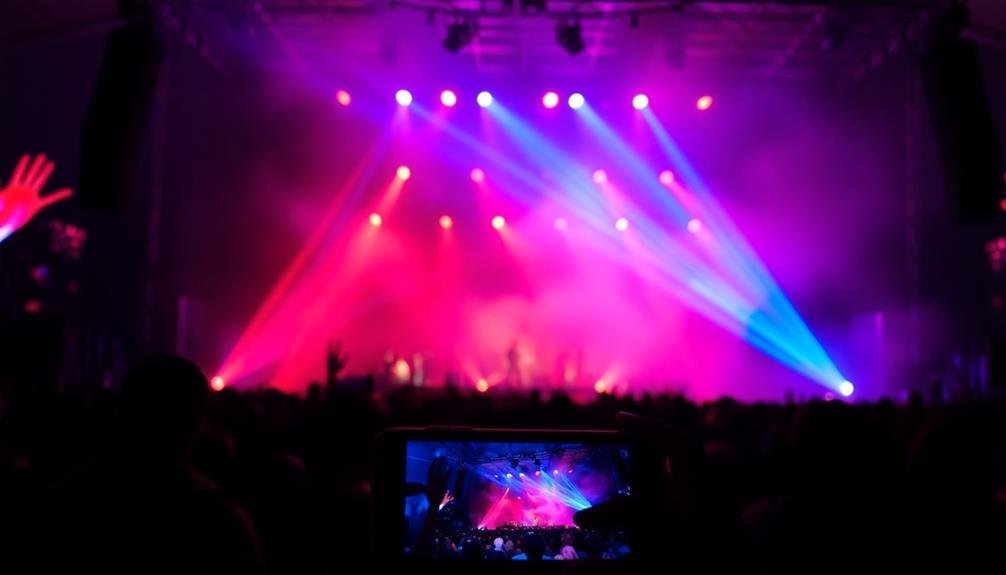
While many concertgoers focus on capturing sharp, clear images, experimenting with slow shutter speeds can yield uniquely artistic results. You'll create dreamy, motion-filled photos that capture the energy of the performance. To achieve this effect, you'll need to use a third-party camera app that allows manual control over shutter speed.
Start by setting your shutter speed to 1/15 of a second or slower. This longer exposure time will blur moving subjects, creating light trails and ghostly images. To avoid camera shake, stabilize your phone against a railing or use a small tripod.
Experiment with different shutter speeds to find the right balance between blur and clarity. For best results, try this technique during dramatic lighting changes or when the artist is making sweeping movements. Colorful stage lights will create stunning streaks across your image.
You can also pan your camera slowly while shooting to add even more motion to the scene. Don't be afraid to take multiple shots – each one will be unique. Remember, the goal is to capture the atmosphere and excitement of the concert, not just a static image of the performers.
Embrace Manual Focus Techniques
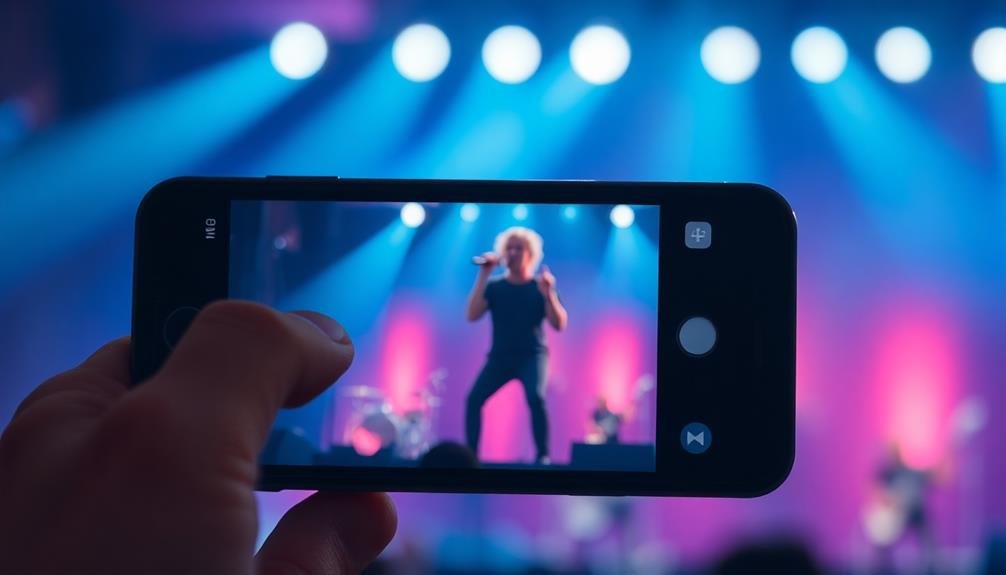
When shooting concerts with your phone, don't rely solely on autofocus.
Instead, try using manual focus techniques like tap-to-focus to guarantee your subject remains sharp, even in challenging lighting conditions.
If your phone camera app offers focus peaking, you'll find it invaluable for achieving precise focus on specific areas of your frame.
These manual focus methods will give you greater control over your concert photos and help you capture crisp, professional-looking images.
Tap-to-Focus for Sharp Subjects
Often overlooked, the tap-to-focus feature on your phone's camera can be a game-changer for concert photography. When you're in a dimly lit venue with constantly moving subjects, this simple technique can help you capture sharp, clear images of your favorite performers.
To use tap-to-focus effectively, start by framing your shot. Then, tap on the main subject you want to focus on, such as the lead singer or guitarist. Your phone will adjust its focus and exposure to optimize for that specific area. This is particularly useful when there's a significant contrast between the subject and the background, like a spotlit performer against a dark stage.
Don't be afraid to experiment with different focal points. Tapping on various areas of the screen can dramatically change the mood and emphasis of your shots. For group shots, try tapping on a central figure to make sure everyone's in focus.
Focus Peaking for Precision
Focus peaking is a powerful tool that can elevate your concert photography to new heights. This feature highlights the areas of your image that are in sharp focus, making it easier to capture crisp, detailed shots in challenging concert environments.
To use focus peaking, you'll need to switch your phone's camera to manual focus mode. Once enabled, you'll see colored outlines around the edges of objects that are in focus. These highlights typically appear in bright colors like red, yellow, or blue, contrasting with the scene. As you adjust the focus, you'll see these highlights shift, allowing you to pinpoint exactly where the sharpest parts of your image are.
In concert settings, focus peaking is particularly useful for capturing performers on stage. You can easily guarantee that the lead singer's face or a guitarist's hands are tack-sharp, even in low light conditions.
Experiment with different focus points to create unique compositions, like focusing on an instrument in the foreground while leaving the performer slightly blurred in the background. This technique gives you more creative control and helps you capture stunning, professional-looking concert photos with your phone.
Leverage Wide-Angle Lens Capabilities
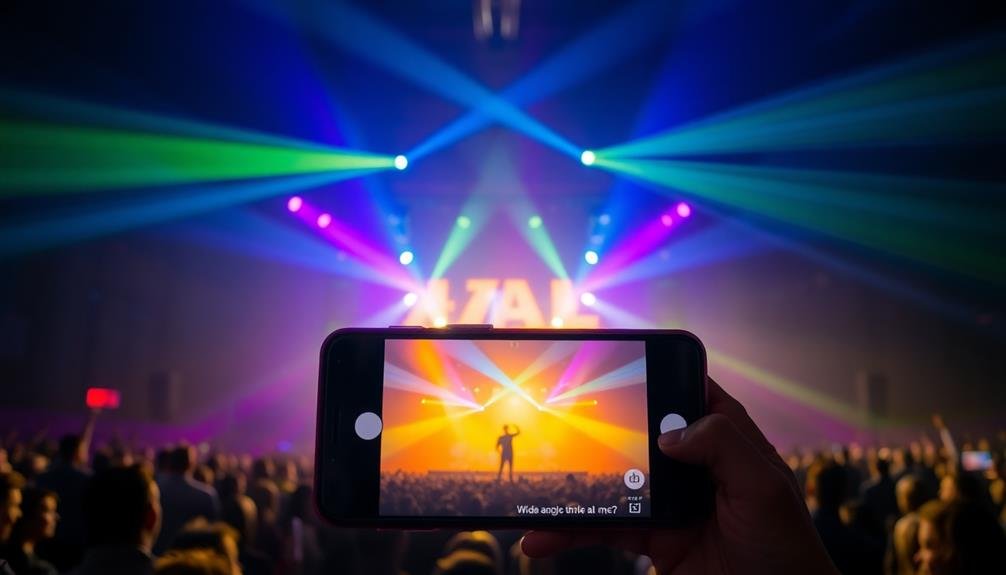
Wide-angle lenses are a concert photographer's secret weapon. If your phone has a wide-angle lens, you've got a powerful tool at your disposal. These lenses capture a broader field of view, allowing you to fit more of the stage, crowd, and venue atmosphere into your shots.
To make the most of this feature, position yourself strategically. Get close to the stage or find an elevated spot for a sweeping view of the entire scene.
Use the wide-angle lens to emphasize the scale of the event. Capture the vastness of the crowd or the impressive stage setup. It's particularly effective for capturing large group shots of the band or expansive light shows.
However, be aware of distortion at the edges of the frame, which can make subjects appear warped. To minimize this, keep important elements centered.
Don't forget to experiment with perspective. Get low to the ground for dramatic upward shots of the performers, or shoot from above to showcase the sea of fans.
Wide-angle lenses also excel in tight spaces, so you can still get great shots even if you're crammed in the crowd.
Perfect Your Zoom Technique
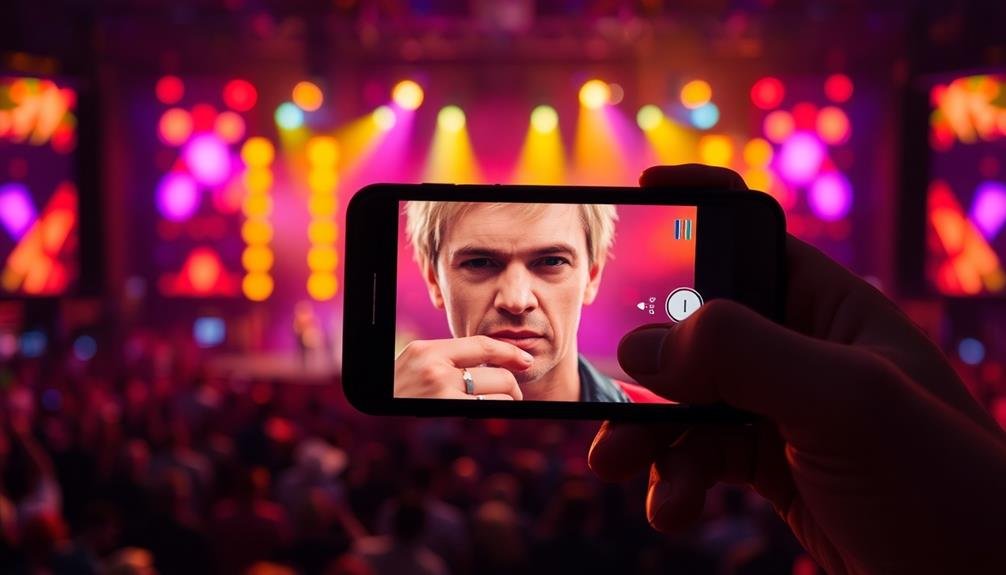
While wide-angle shots capture the grandeur of a concert, you'll also want to get up close and personal with the performers. That's where mastering your phone's zoom feature comes in handy.
Start by understanding the difference between optical and digital zoom. Optical zoom uses your phone's lenses to magnify the image without losing quality, while digital zoom crops and enlarges the picture, often resulting in pixelation.
If your phone has optical zoom, use it to its full potential. For digital zoom, be cautious and avoid zooming in too far. Instead, move closer to the stage if possible.
When zooming, steady your hands or use a mini tripod to reduce shake. Tap on the screen to focus on your subject before taking the shot.
Try the burst mode while zoomed in to capture fast-moving performers. This increases your chances of getting a sharp, well-timed photo.
Experiment with different zoom levels to find the sweet spot between detail and image quality. Remember, a slightly grainy photo with great composition is often better than a blurry close-up.
Practice your zoom technique before the show to guarantee you're ready when the moment strikes.
Capture Silhouettes Against Stage Lights
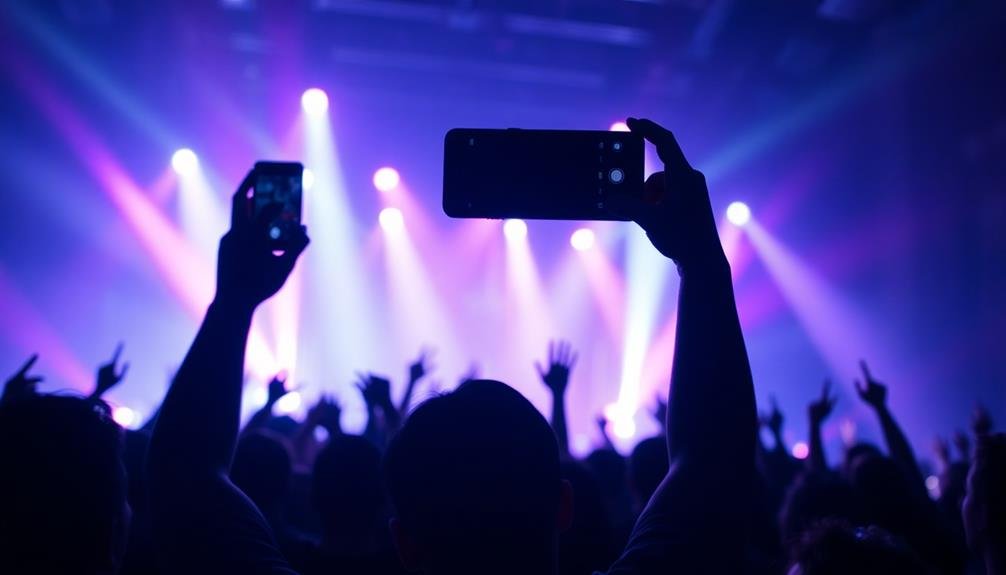
One of the most striking images you can capture at a concert is a silhouette against vibrant stage lights. To achieve this effect, position yourself so that the performer or crowd is between you and the bright stage lights. Turn off your phone's flash and adjust the exposure settings to focus on the brightest part of the scene. This will cause the foreground subjects to appear as dark silhouettes.
Experiment with different angles to create interesting shapes and compositions. Try capturing a raised hand, a guitar neck, or the entire band's outline. Timing is essential, so anticipate moments when the stage lights are at their brightest or most colorful.
Look for opportunities when smoke or fog machines are in use, as they can add depth and atmosphere to your silhouette shots.
For best results, use your phone's manual or "pro" mode if available. Reduce the ISO to minimize noise and adjust the shutter speed to freeze motion or create light trails.
Remember to hold your phone steady or use a small tripod for sharper images. With practice, you'll be able to capture dramatic silhouettes that convey the energy and atmosphere of the concert.
Explore Time-Lapse for Crowd Movements
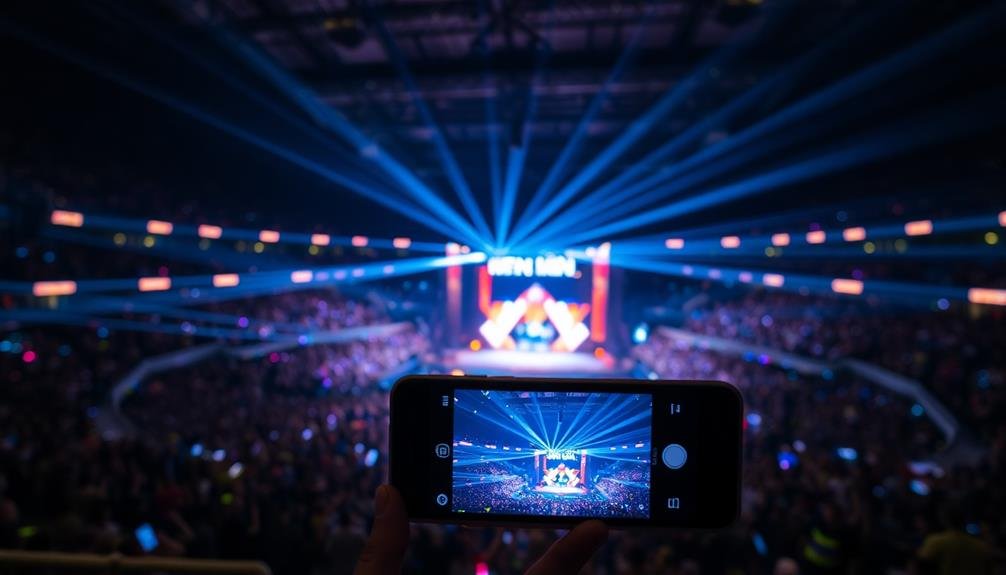
Time-lapse photography can transform your concert experience by capturing the venue's evolving atmosphere throughout the night.
You'll showcase the crowd's energy as it builds from the opening act to the headliner's finale.
Additionally, you can record the stage's transformation, from setup to teardown, giving viewers a behind-the-scenes glimpse of the event's full lifecycle.
Capture Venue Atmosphere Changes
Concerts are dynamic experiences, with the venue's atmosphere shifting dramatically throughout the night. Your phone can capture these changes, preserving the evolving ambiance. Start by taking a photo when you first arrive, capturing the empty venue's anticipation. As the crowd fills in, snap shots of the growing energy.
During the show, focus on lighting changes. Most phones now offer manual exposure controls, allowing you to adjust for dramatic spotlights or moody low-light scenes. Don't forget to capture the crowd's reactions at key moments – their enthusiasm is part of the atmosphere.
Here's a quick guide to capturing venue atmosphere changes:
| Time | What to Capture | Phone Setting |
|---|---|---|
| Pre-show | Empty venue | Wide-angle lens |
| Doors open | Growing crowd | Time-lapse video |
| Main act | Stage lighting | Manual exposure |
After the show, take a final shot of the venue as it empties out. This series of images will tell the story of the night's progression, from quiet anticipation to electrifying performance and back to calm. You'll have a complete visual narrative of the concert's atmosphere, all captured with your phone.
Show Crowd Energy Evolution
As the night progresses, a concert's crowd transforms from a collection of individuals into a unified, pulsing entity. To capture this evolution, you'll want to experiment with time-lapse photography on your phone. Most modern smartphones have built-in time-lapse features that you can easily access through your camera app.
Find a stable position with a good view of the crowd, preferably from an elevated spot. Set up your phone on a small tripod or prop it securely against a sturdy surface. Start the time-lapse as people begin to fill the venue, and let it run throughout the show. You'll end up with a mesmerizing video that condenses hours of crowd movement into seconds.
To enhance your time-lapse, try capturing different angles. A side view can show the crowd's waves and surges, while a front-facing shot might reveal the gradual push towards the stage.
Experiment with different intervals between shots to find the right balance between smoothness and capturing key moments. Remember to keep an eye on your battery life and storage space, as time-lapses can be demanding on both.
Record Stage Setup Transformations
Stage setups can transform dramatically throughout a concert, and capturing these changes adds another layer to your visual storytelling. Your phone's time-lapse feature is perfect for documenting these shifts.
Start by finding a stable spot with a clear view of the stage. Set up your phone on a small tripod or lean it against a fixed object to keep it steady.
Begin recording before the show starts to capture the initial setup. You'll want to include the crew's work, equipment placement, and lighting adjustments. As the concert progresses, your time-lapse will reveal how the stage evolves for different acts or song sets.
Pay attention to moving platforms, changing backdrops, and shifting light rigs. To create a more dynamic time-lapse, try varying your frame rate. A slower frame rate works well for pre-show setup, while a faster one captures the energy of quick changes between acts.
Don't forget to account for your phone's battery life – bring a portable charger if needed. After the show, edit your time-lapse to highlight the most striking transformations, creating a unique visual journey through the concert's production elements.
Use Portrait Mode Creatively
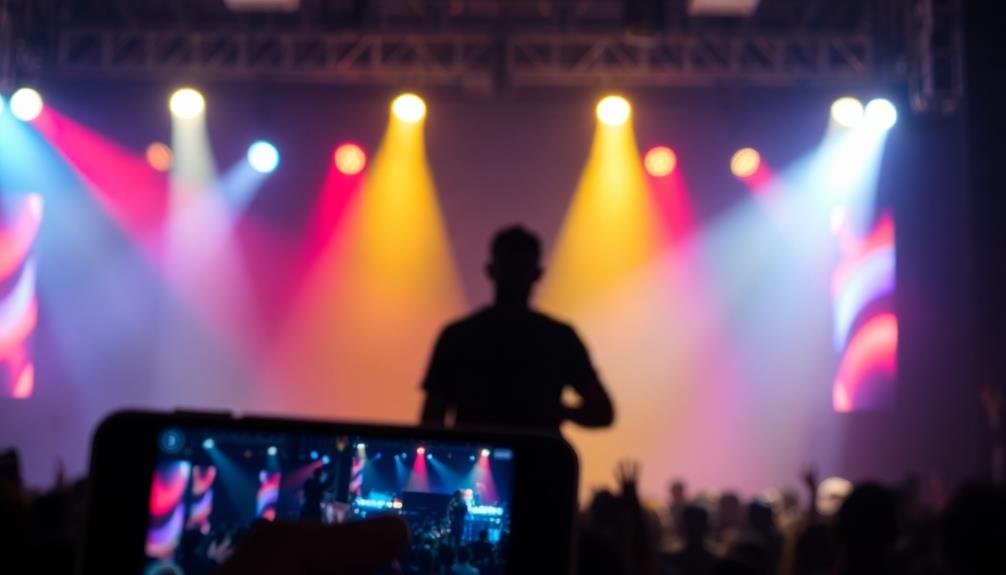
Portrait mode isn't just for selfies. At concerts, you can use this feature to create stunning, professional-looking shots that capture the energy of the performance. When you're in the crowd, try using portrait mode to focus on a single band member while blurring the background. This technique works particularly well for lead singers or guitarists during solos.
You can also experiment with portrait mode to highlight unique stage elements. Frame your shot to include interesting lighting fixtures, speakers, or set pieces in the foreground, letting the performers become a soft backdrop. This approach adds depth and context to your images.
Don't forget about your fellow concertgoers. Use portrait mode to capture the emotions on fans' faces as they sing along or react to the music. These shots can tell a compelling story about the concert experience.
For a creative twist, try using portrait mode on inanimate objects at the venue. Focus on a guitar pick, drumstick, or setlist, with the stage blurred in the background. These detail shots can add variety to your concert photo collection and provide a unique perspective on the event.
Apply Night Mode for Low Light
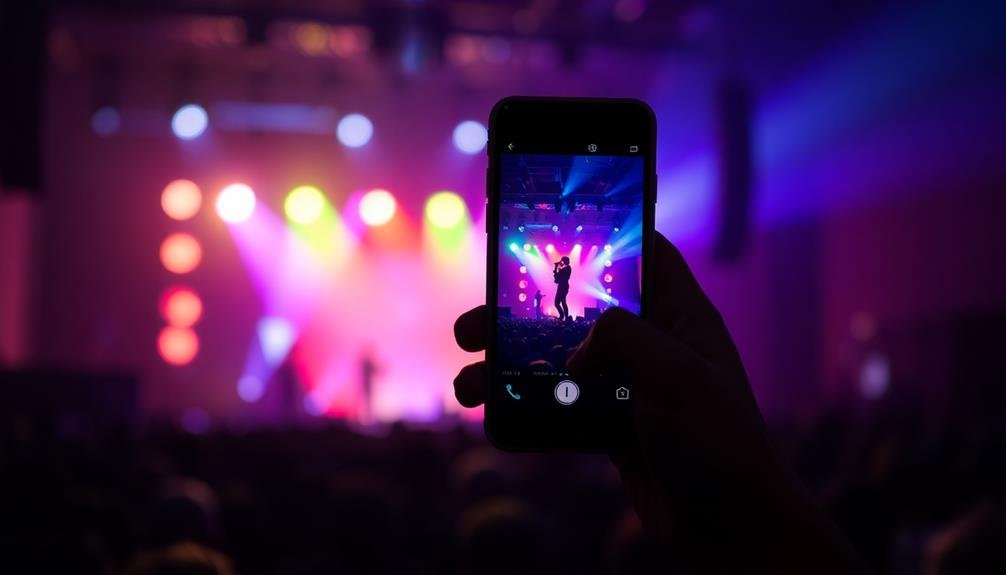
Night mode on your phone can be a game-changer for concert photography in low-light conditions.
You'll capture the atmospheric stage lighting with enhanced clarity and vibrant colors, creating stunning visual effects.
Don't forget to experiment with crowd shots, as night mode can accentuate the glow of phone screens and lighters, adding depth and ambiance to your images.
Capture Atmospheric Stage Lighting
Dramatic lighting can make or break your concert photos. To capture the essence of atmospheric stage lighting, you'll need to work with your phone's camera settings.
Start by turning off your flash, as it can wash out the carefully designed lighting effects on stage. Instead, tap on the brightest areas of your screen to adjust exposure and focus, ensuring you don't lose the vibrant colors and contrasts.
Experiment with your phone's HDR mode to balance the bright spotlights and darker areas. This feature can help you retain more detail in both highlights and shadows.
For a creative twist, try using your phone's "Live" or "Motion" photo features, which capture a few seconds of movement. This can result in stunning light trail effects from moving spotlights.
Don't be afraid to embrace the silhouettes created by backlighting. These can produce dramatic, artistic shots that capture the atmosphere of the concert.
Finally, if your phone has a "Pro" or "Manual" mode, adjust the ISO and shutter speed to fine-tune your exposure.
Enhance Crowd Glow Effects
While capturing the stage's vibrant lighting is important, don't forget about the energy emanating from the crowd. Your phone's Night Mode can help you enhance the crowd's glow effects, creating stunning images that capture the concert's atmosphere.
To use this feature effectively, activate Night Mode in your camera settings before the show starts.
When you're ready to shoot, steady your phone and focus on the crowd. Night Mode will automatically lengthen the exposure time, allowing more light to enter the sensor. This technique works particularly well when concertgoers are holding up lit phones or lighters, creating a sea of twinkling lights.
To add depth to your photos, try capturing the crowd from different angles. Shoot from above to showcase the expanse of the audience, or get low to emphasize the glow against the dark background.
Experiment with framing, including both the crowd and stage elements for context.
Stabilize Your Shot With Accessories
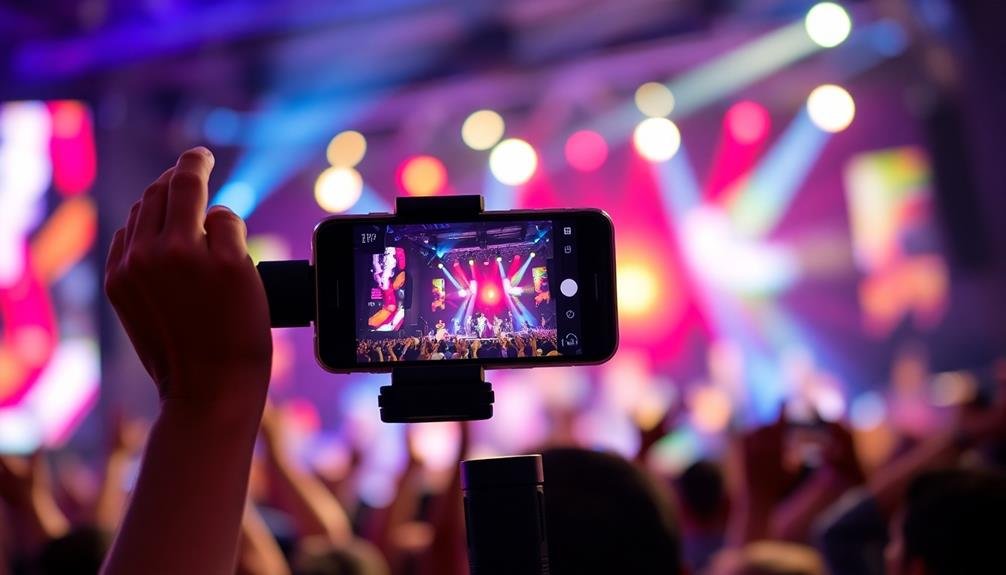
Concert-goers know that capturing great photos in low light and crowded venues can be challenging. To stabilize your shot and improve image quality, you'll want to contemplate using accessories with your phone. A compact tripod or monopod can make a world of difference, allowing you to keep your device steady even in bustling crowds.
For hands-free operation, try a clamp mount that attaches to railings or nearby structures. This lets you set up your shot and enjoy the show simultaneously. If you're looking for versatility, a flexible tripod with wrappable legs can adapt to various surfaces and angles.
Don't forget about smartphone-specific stabilizers like gimbals. These handheld devices use motors to counteract your hand movements, resulting in smoother videos and sharper photos.
Here's a quick comparison of popular stabilizing accessories:
| Accessory | Portability | Stability | Versatility | Cost | Ease of Use |
|---|---|---|---|---|---|
| Compact Tripod | High | Medium | Medium | Low | Easy |
| Clamp Mount | High | High | Low | Low | Easy |
| Flexible Tripod | High | Medium | High | Low | Medium |
| Gimbal | Medium | High | High | High | Medium |
| Monopod | High | Medium | Medium | Low | Easy |
Choose the accessory that best fits your needs and budget to elevate your concert photography game.
Edit On-The-Go With Apps
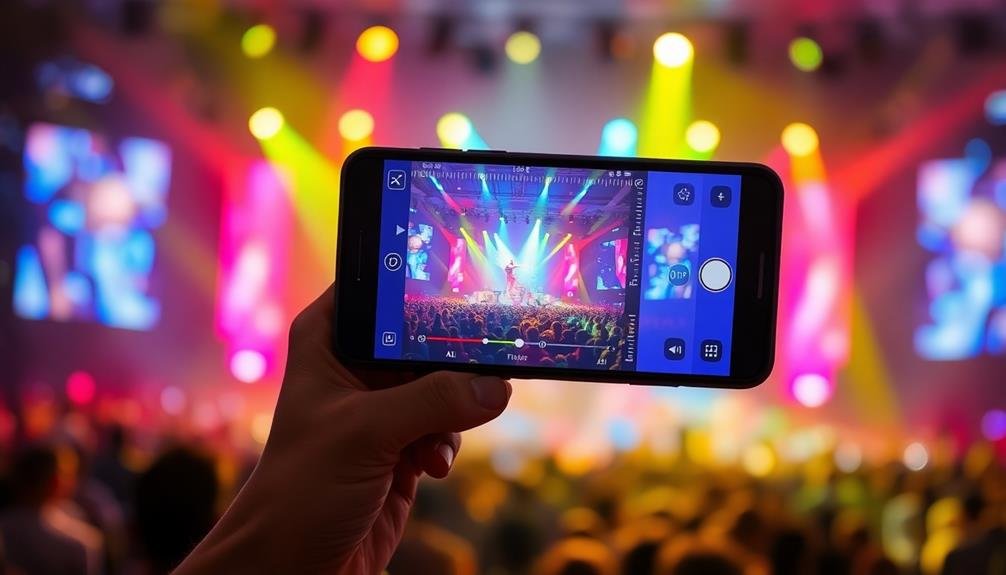
Once you've captured your concert shots, it's time to make them shine. Mobile editing apps offer powerful tools to enhance your photos right on your phone. You don't need to wait until you're home to perfect your images; instead, you can edit and share them while the concert's still fresh in your memory.
Popular apps like Snapseed, VSCO, and Lightroom Mobile provide a wide range of editing features. These apps allow you to:
- Adjust exposure, contrast, and color balance
- Apply filters and presets for quick enhancements
- Crop and straighten images for better composition
- Add text or stickers to personalize your photos
When editing concert photos, focus on bringing out the vibrant colors and dynamic lighting typical of live performances. Don't be afraid to experiment with different effects, but remember to maintain the authenticity of the moment.
Avoid over-editing, which can make your photos look artificial. For more advanced edits, consider apps that offer selective adjustments or masking tools. These features let you fine-tune specific areas of your image, such as brightening the performer's face without affecting the background.
With practice, you'll develop a signature editing style that makes your concert photos stand out on social media.
Maximize Your Phone's Pro Features
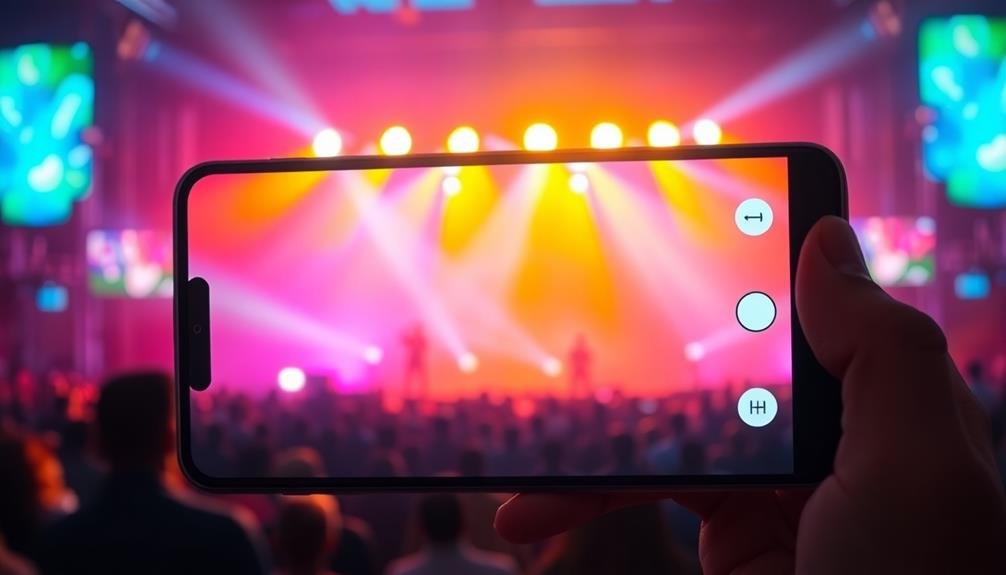
Today's smartphones come equipped with advanced camera features that rival professional equipment. To capture stunning concert photos, you'll want to maximize these pro features.
Start by enabling HDR mode, which combines multiple exposures to handle challenging lighting conditions common at concerts. Next, switch to manual mode for greater control over settings like ISO, shutter speed, and focus. Increase your ISO to capture more light in dark venues, but be mindful of noise in your images.
Experiment with your phone's night mode for low-light situations, as it can considerably improve image quality without flash. If your phone has optical zoom, use it instead of digital zoom to maintain image quality when shooting from afar.
Don't forget to utilize burst mode for fast-moving performers, increasing your chances of catching the perfect shot. Some phones offer RAW image capture, giving you more flexibility in post-processing.
Frequently Asked Questions
How Can I Protect My Phone From Damage During Crowded Concerts?
You can protect your phone at crowded concerts by using a sturdy case, keeping it in a zippered pocket, or using a lanyard. Don't hold it up for extended periods, and be aware of your surroundings to avoid accidental drops.
Are There Any Legal Issues With Taking Photos at Concerts?
You should be aware of potential legal issues when taking concert photos. Many venues prohibit professional cameras. Always check the venue's policy beforehand. Artists may also have specific rules about photography, so respect their wishes to avoid problems.
How Do I Capture Audio Along With Photos During Live Performances?
You can capture audio while taking photos by using your phone's video mode. Simply start recording video and take screenshots during the performance. Alternatively, use a dedicated audio recording app alongside your camera app for better sound quality.
What's the Best Way to Share Concert Photos on Social Media Instantly?
You'll want to use your phone's quick share features. Connect to Wi-Fi or use mobile data, then snap your photos and instantly share them on platforms like Instagram or Facebook. Don't forget to use relevant hashtags for more visibility.
Can I Use External Lenses With My Phone for Concert Photography?
Yes, you can use external lenses with your phone for concert photography. They'll help you capture wider angles or zoom in closer to the stage. Clip-on lenses are easy to attach and can greatly enhance your concert shots.
In Summary
You've now got a toolkit of concert photo tricks for your phone. From burst mode to manual focus, you're ready to capture stunning shots. Don't forget to experiment with HDR, slow shutter speeds, and wide-angle lenses. In low light, night mode's your friend. Stabilize with accessories and edit on-the-go. By mastering these techniques and your phone's pro features, you'll be snapping concert photos like a pro in no time.





Leave a Reply